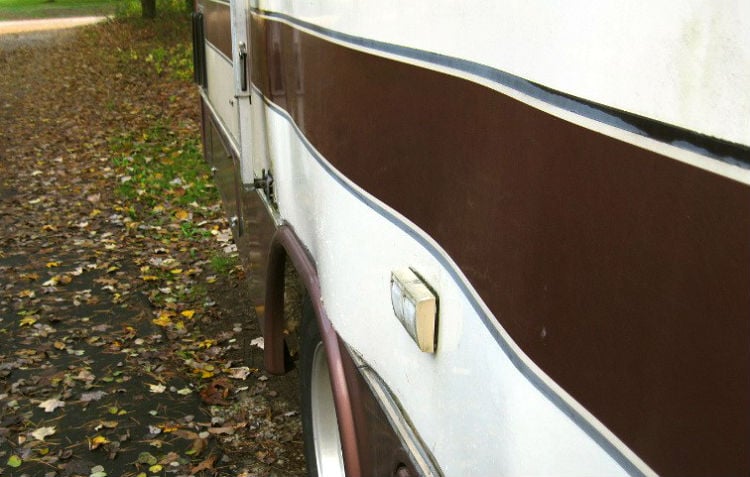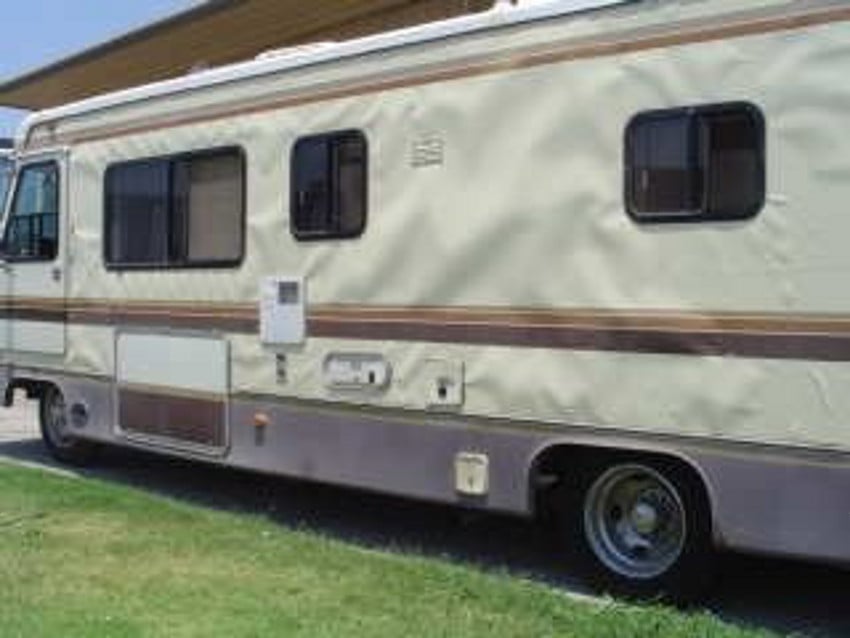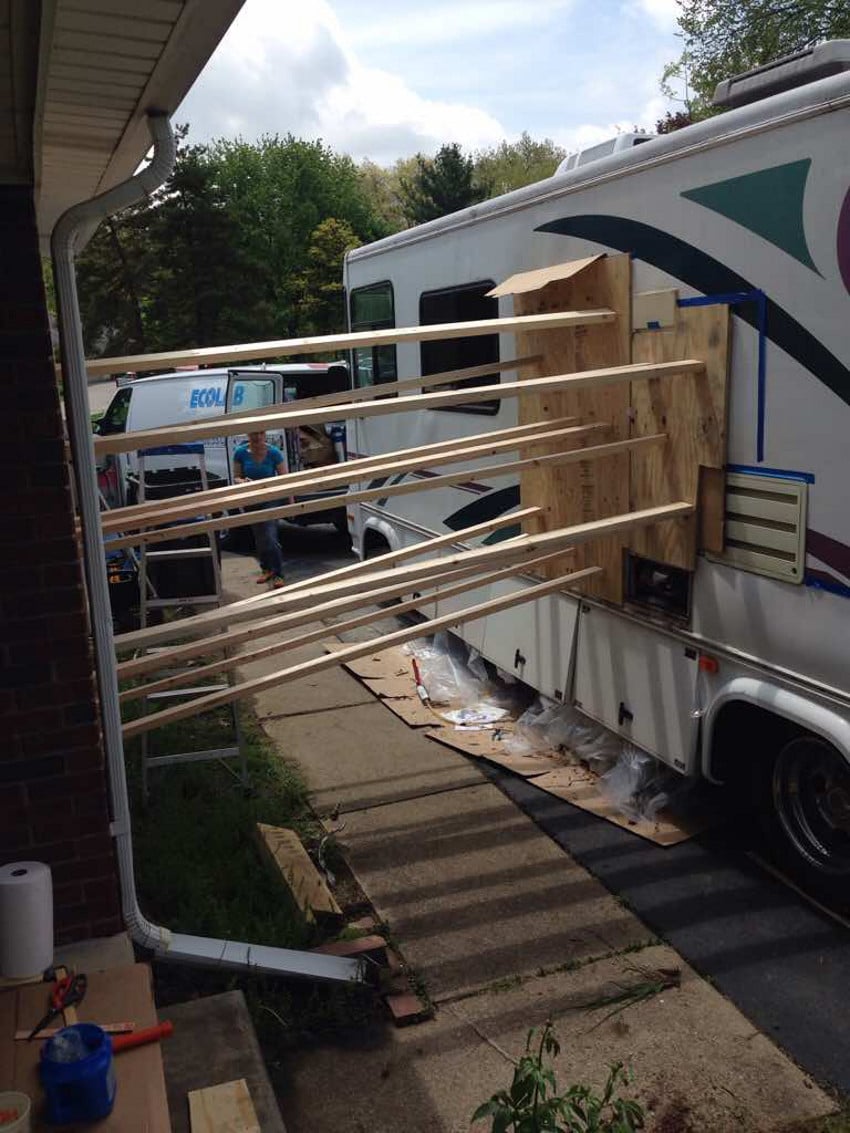what does it mean when the outside of aluminum on a rv starts to bubble
Don't worry, this isn't your optics playing tricks on you. This is a real RVer with serious RV delamination issues.

Photograph courtesy of iRV2 Forums
What is RV delamination?
Aluminum siding used to be the de facto pick for RV manufacturers, but most have switched to fiberglass siding because of its immovability, lightweight properties, and lower overall cost. RV walls are also easier to produce and install.
They're built like a sandwich; the exterior fiberglass and interior decorative walls are the "bread," and in-between contains the "meat," which is ii layers of wood and Styrofoam. These materials are vacuum bonded to each other, then the "bread" in order to serve as backing reinforcements.
Fiberglass is extremely flexible, durable, and dissimilar aluminum, can bounciness back from common hazards like road debris and hail. Unfortunately, the "meat" underneath the fiberglass isn't quite every bit durable. If something impacts the RV roof or wall it might not puncture the fiberglass, but information technology can hit information technology hard enough to permanently dent the underlying Styrofoam and wood substrates.

This RV delamination trouble is obvious.
The result is a convex air pocket that causes bonding amanuensis failure and separation. A bubble forms over the unglued pocket, which will grow in size over time as the fiberglass-walled RV flexes with normal employ. The bubble volition gradually fissure and trap moisture inside, causing further harm.
Bonding agent separation can also happen when water seeps in through a roof, window, or vent seam with inadequate or deteriorated lap sealant. The separation creates a river of moisture and the outcome is a soggy RV "sandwich" eventually consisting of cruddy blisters, bulges, and waves on the outside and irreparable wood rot on the inside.
Most owners don't recognize the signs of RV delamination until it'southward too late. Fiberglass RV walls can look shine on the outside while real damage is unseen. When the problem becomes obvious, repair is unremarkably expensive and oftentimes impossible to fix.
Recognizing and repairing RV delamination
Whether you own a fiberglass RV at present or yous're shopping for a used one, it'due south of import to know the signs of this expensive problem. Kickoff, do a thorough walk-around in direct sunlight and closely inspect the side, front and rear RV walls besides as the areas around windows and roof vents.
The fiberglass should be flat and smooth. If you notice any waves, bubbles, or creases, press them with your finger. If the area feels spongy, you have probably spotted RV sidewall delamination. Double bank check by tapping it lightly with a plastic utility serving spoon or other implement.
A hollow sound indicates delamination. When the RV is parked in shade, observe how the waves and bubbles react. If they go smaller and flatter, that's another indicator of RV sidewall delamination.
If you're merely browsing the market for a used fiberglass RV, now's your run a risk to run. You do not want to own a RV with delaminated sidewalls, fifty-fifty if the owner is giving it abroad for free.
The repair costs rarely justify the effort and expense of repair (yet there are exceptions, so go on reading). If water has permeated RV sidewalls, information technology may take already weakened the RV's structural integrity. Mold spores can fester on the damp inner wood layer and crusade health issues for the owner. You won't know any of this is occurring without peeling away the outer layer.

Pressing the substrates back together during the delamination repair.
My RV has delaminated. Now what?
The nearly common cause of the delamination problem is an owner failing to periodically re-seal seams with lap sealant. Every bit a issue, RV insurance companies and extended warranties don't commonly cover RV delamination repairs.
If you're in this unfortunate situation only the damage is relatively pocket-size, you can try a delamination repair kit. These kits cost $200 to $300 and include a heavy-duty, marine-class bonding system that can be used to re-glue the fiberglass to the underlying layers. They come with syringes and tubing for injecting the sealant into tight spots. Still this solution only works if the inner layer is free from water impairment.
If the problem is big just y'all accept a never-say-die mental attitude, a DIY approach to RV delamination repair is possible. Notice how this hearty iRV2 Forums fellow member documented his entire repair job for anyone dauntless enough to try it themselves.
Have you experienced sidewall delamination on your rig? If and so, what did y'all do well-nigh it? Let u.s.a. know, because there are many fiberglass RV owners who would appreciate reading about your feel.

Rene Agredano and her husband, Jim Nelson, became total-fourth dimension RVers in 2007 and have been touring the country ever since. In her web log, Rene chronicles the ins and outs of the total-timing life and brings readers along to meet the fascinating people and amazing places they visit on the road. Her road trip adventures are chronicled in her blog at LiveWorkDream.com.
Source: https://rvlife.com/rv-delamination/
0 Response to "what does it mean when the outside of aluminum on a rv starts to bubble"
Post a Comment